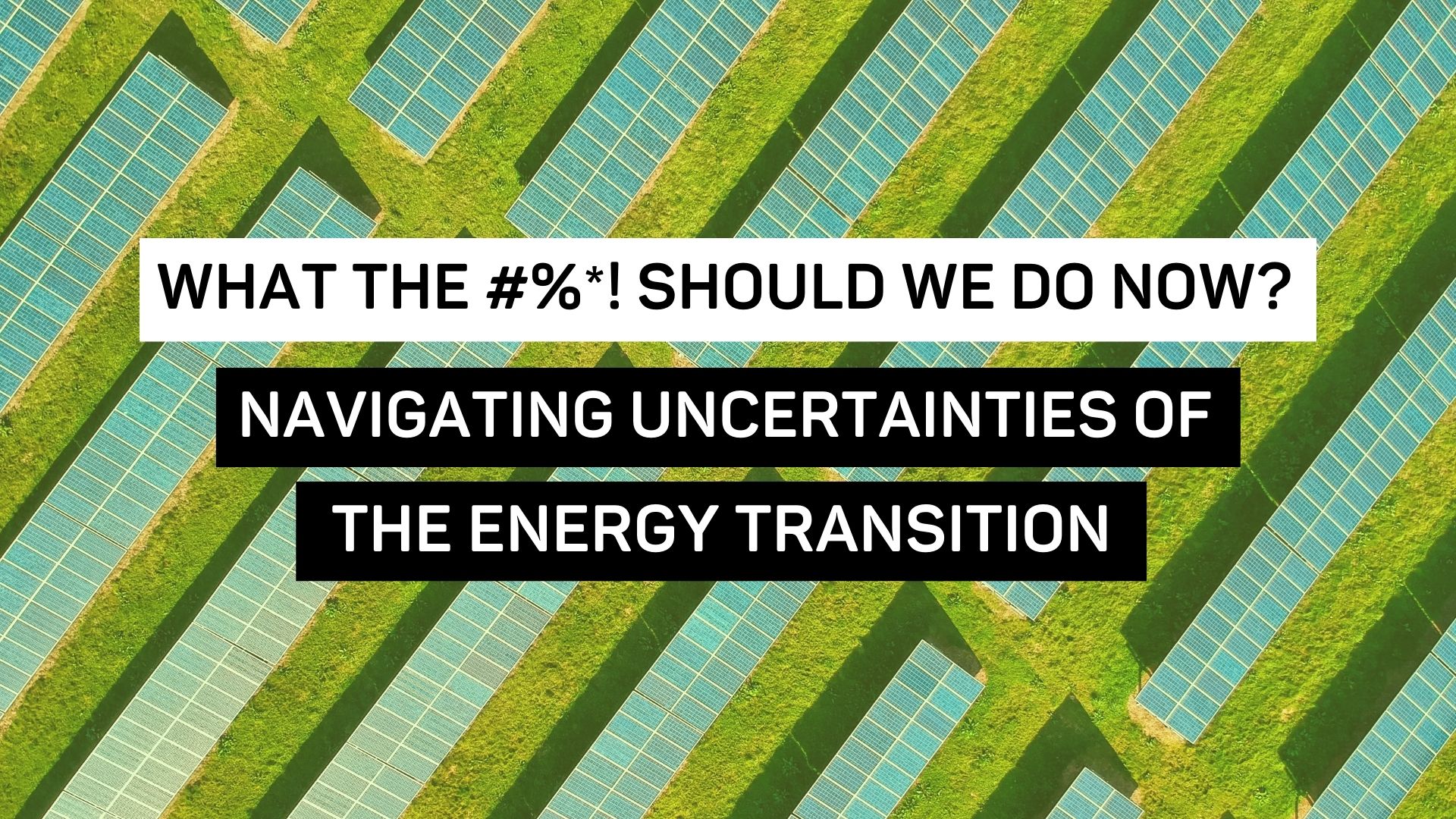
What the #%*! should we do, now? Navigate the uncertainties of the energy transition and turn insight into action
Rohrbeck Heger joined E.ON for an expert talk on strategic foresight at the trade fair E-world Energy & Water 2022.
Key Takeaways:
- Many different and highly uncertain factors shape the present and future of the energy transition. Instead of ignoring this uncertainty, we must work proactively with it, accounting for multiple probable outcomes.
- In an environment of many unknowns, foresight methodologies provide structure and help us to derive actionable insights. Based on this, we can move forward, make decisions, and get stuff done.
- E.ON deploys various foresight methodologies to build a resilient strategy and remain a key player in the transition to renewable energy.
- Rohrbeck Heger enables organizations to become future-prepared, grasp emerging opportunities, mitigate threats, and create a prosperous future with our strategic foresight expertise.
It’s human nature to avoid dealing with uncertainty. And the further one looks into the future to plan for eventualities, the less clear and more uncertain things get. Cue our tendency to act in avoidance, or revert to an over-reliance on precedent (by this we mean assuming that the future will look anything like what we’ve observed in the past). But when it comes to building a robust and resilient future-proof strategy, uncertainty is the name of the game: a critical aspect that is essential for success. Rather than running away from the unknown, building a strategy that can weather whatever comes requires us to embrace uncertainty instead.
Strategic Foresight is a methodology that identifies, analyzes, and proactively works with uncertainty, enabling organizations to become truly future-prepared. And if there is one industry at the moment that finds itself awash in a proverbial sea of uncertainty, it’s the energy sector. War in Ukraine, an accelerating climate crisis, and transformative technologies are just three factors that make the future of the energy industry especially difficult to predict, and thus a compelling case study for strategic foresight. Foresight methodologies, such as scenario building, trend radars, and innovation portfolio assessments, can be particularly powerful when it comes to navigating the energy landscape at this critical juncture.
Which was why we were especially excited to host an expert talk at the E-world Energy & Water trade fair in June, the foremost gathering of European and international professionals in this crucial industry. Facing acute challenges in the coming weeks, months and years, innovation and strategy professionals from the energy industry were invited to join us for an instalment of the E-world Speakers Corner series, where Rohrbeck Heger joined E.ON to address these very topics. A fitting partner, E.ON is not only a pioneer in renewable energy and a key player in the European market, but also boasts a mature foresight practice.
Entitled “What the #%*! should we do, now? Navigate the uncertainties of the energy transition and turn insight into action,” Dr. Alejandro Berbesi, Manager at Rohrbeck Heger was joined by Head of Foresight at E.ON Thomas Boermans to discuss the deep uncertainties facing the industry, how foresight helps teams navigate the unknown, and what the future of the energy industry may hold.
Geopolitical tensions and sustainable consumer behavior voted most uncertain factors facing the energy industry towards 2030
“Just looking at the news this morning, you realize, ‘oh, we don’t know what’s going to happen to the energy supply this winter.’ So if you’re working with so much uncertainty, how can you make sense of it all and make decisions? That’s exactly what we’ll be discussing today,” explained Alejandro Berbesi. To kick things off, he took the temperature of a hot topic: identifying the most uncertain factors facing the energy industry at this moment in time. Looking 10 years into the future, Berbesi collected the audience’s live input by rating the uncertainty level of select factors, with 0 as “very predictable” and 5 as “very unpredictable.” Here’s how the audience voted:
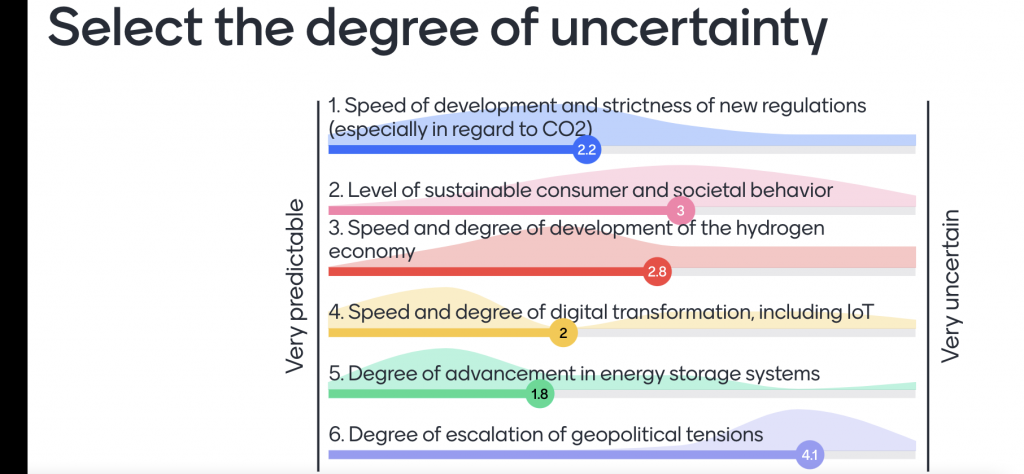
The results showed that each examined factor had a mid-to high degree of uncertainty, and not one was voted as “highly certain.” The topics of evolving geopolitical tensions as well as consumer behavior/societal attitudes towards sustainability were voted as being most uncertain, with participants unsure how these would play out in the future. Digital transformation and energy storage systems were voted as least uncertain. Signalling a divided opinion among those present, regulations – especially in regards to CO2 – had assessments that spanned the full range from highly certain to highly uncertain.
The take-away from this quick poll? Overall, experts within the energy industry are operating in an uncertain environment and system, juggling factors that are highly interrelated. The good news? Foresight methodologies can help organizations structure this information and come up with actionable insights, deal proactively with inherent uncertainty and develop a robust and resilient strategic approach.
How does E.ON use foresight?
Thomas Boermans, Head of Foresight at E.ON, walked the group through two ways that his team uses foresight to keep the energy company ahead of the curve and a leader in the European transition to renewables. One key tool is the team’s Trend Radar, where E.ON keeps tabs on a number of relevant trends, from the Future of Work to the Future of Society. The trend radar illustrates the time to impact: the farther out the trend is shown on the radar, the longer it will take to reach maturity.
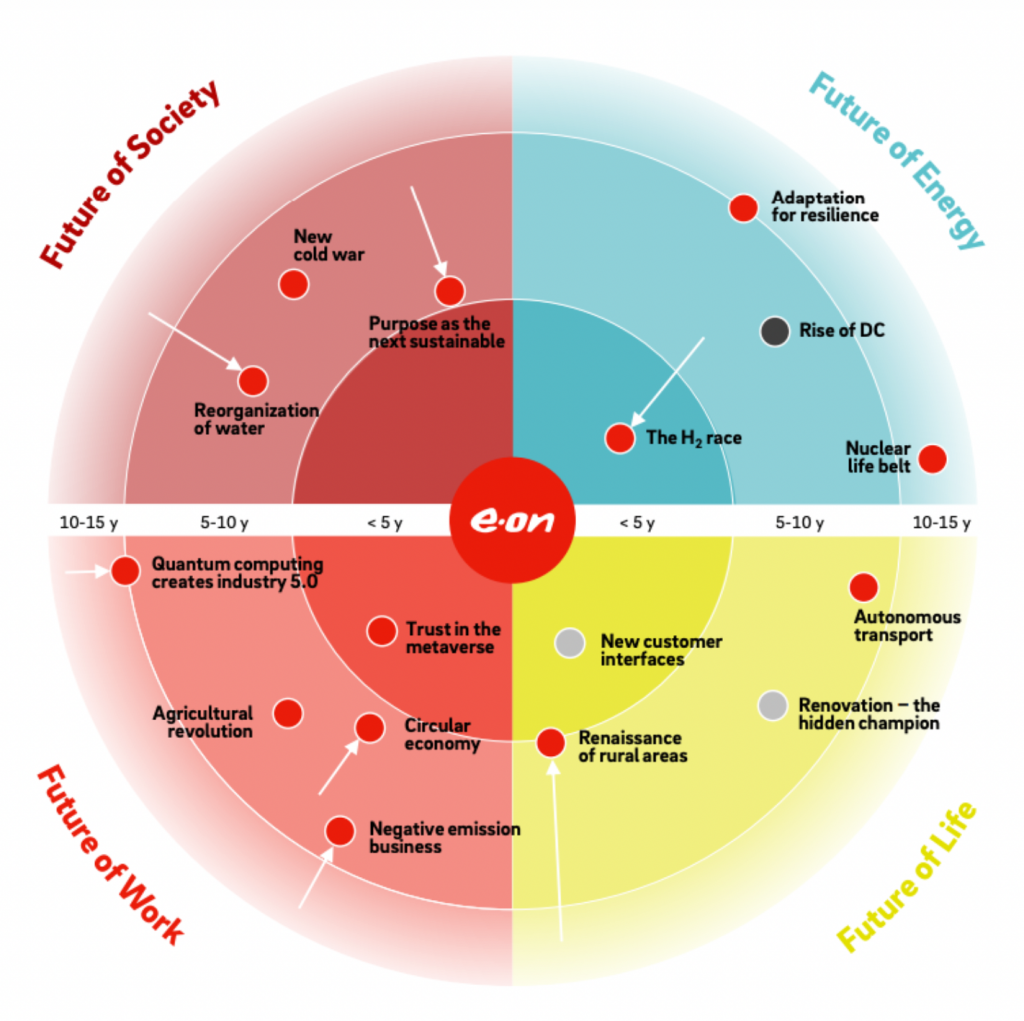
One example Boermans highlighted was the “Renaissance of Rural Areas,” a trend that describes a shift from urban to rural living, assuming that many consumers would prefer a healthier and more sustainable lifestyle, closer to nature in the coming years. For a utility company, this could require among many things building rural infrastructures to support renewable energy use in those areas. What caught Boermans and his team by surprise was the actual time to impact – the speed of this trend was accelerated greatly by the COVID-19 pandemic and has developed more quickly than originally assessed.
In addition, Boermans shed light onto E.ON’s strategic portfolio workshops, which map E.ON’s innovation portfolios to its trend radar, company strategy, and consumer profiles/drivers. This exercise over a series of virtual workshops is ultimately about company-wide transparency and bringing real value from foresight, driving impact throughout the company, especially at the highest levels of decision making. By engaging with future-focused insights, company strategy, and a consumer-centric approach, these workshops helped E.ON to make important calls such as: “do we have any legacy innovation projects that no longer align with our current understanding of where things are headed, and where we want to be in the future?” Resilient companies change over time, and this exercise ensures that its strategy and innovation portfolios change accordingly.
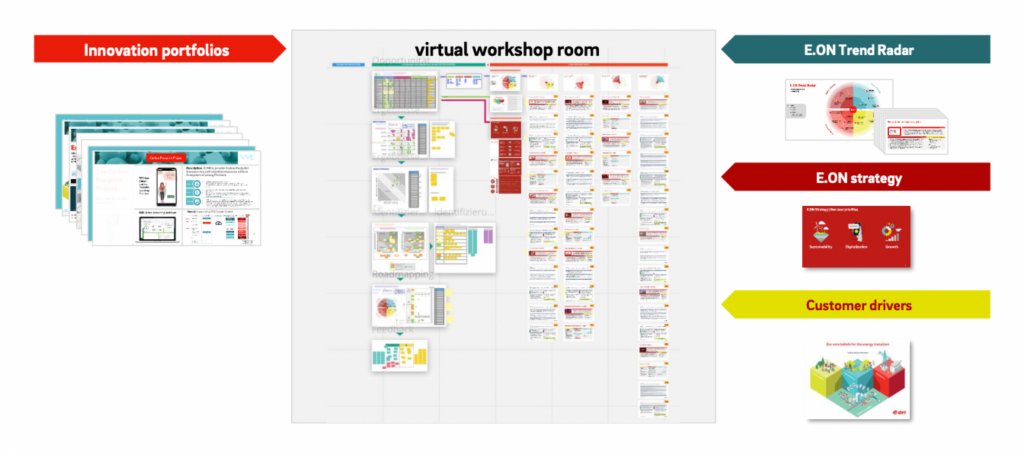
Exploring plausible futures with scenarios
“In the energy transition,” explained Rohrbeck Heger Manager Dr. Alejandro Berbesi, “an efficient or a good strategy is not the one that tries to extrapolate from the past and hope for the best. Instead, it’s the one that’s prepared for a different future.” Whereas forecasting assesses past data and experience, formulates assumptions based on these, and then makes a plan based on such assumptions, strategic foresight takes a different approach.
One foresight exercise that illustrates this is scenario-based strategizing, wherein participants are tasked with traveling to the future and then connecting the dots backwards. What should your company start preparing today to remain competitive in a possible, plausible future? “Let me tell you,” said Berbesi, “this is not an easy process. It’s not the way we were taught to think – from the future, backwards to the present.”
The scenario-based strategizing approach is based on the common understanding that various factors can develop in different ways as time progresses. Take, for example, the aforementioned uncertainty factor for the energy sector: society’s attitude towards sustainability. In a plausible future, either everyone is very conscious of their ecological footprint and ready to make sacrifices, or it could develop the other way, with no one ready to change their attitude. From these two extremes we then project different scenarios.
“These are extreme versions of the future,” said Berbesi, “and this is very difficult because we tend to stipulate based on what we have experienced, what we feel, what feels okay, what feels natural. But what we do through the (scenario-building) process is push really hard to think about the extremes.” An example he shared was of a workshop with an airline client back in 2019, when one of the scenarios projected that all short-haul flights within Europe were canceled. Participants grumbled that this was too unlikely to happen and too extreme to consider. Of course, little did anyone know that this very scenario would come to pass in the early months of 2020.
A new definition of pretty
To round up the discussion, Boermans took a moment to share one of the tenets that defines E.ON’s current vision for the future of the energy industry. To illustrate this vision he presented a speedometer (pictured below), depicting the industry’s speed of decarbonization.
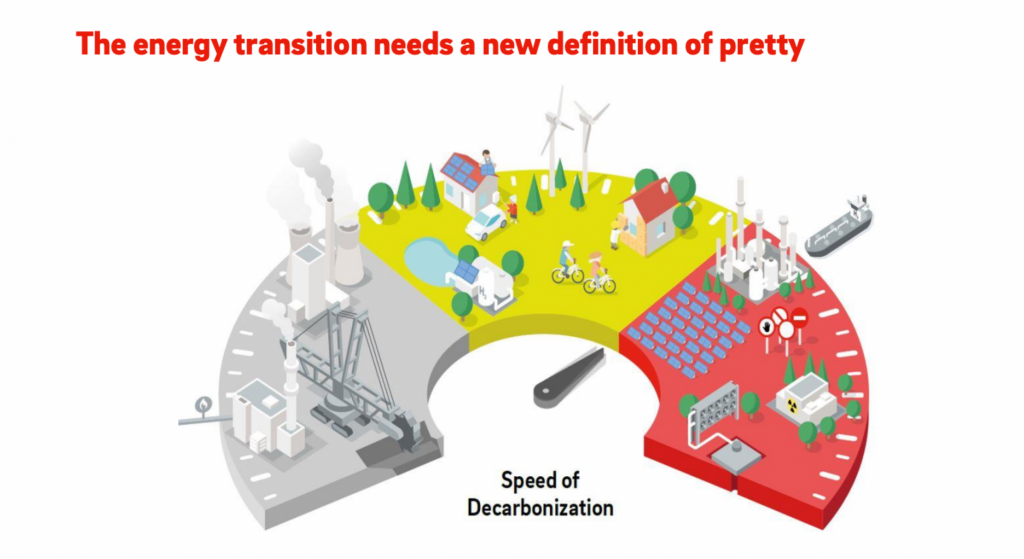
To the left, in the gray area, is the centralized, old energy world – depicting energy’s past. To the center is what we consider today to be a “pretty” energy picture: decentralized, renewable energy production on the part of green-oriented consumers, such as solar panels on private homes. And while this is good and important, it’s not enough. In order to meet the required speed of decarbonization to prevent warming beyond 1.5 degrees Celsius, we require a full industrialization of renewable energy, as is depicted to the right of the image.
“The point is,” Boermans explained, “if we exclusively rely on this green world where all consumers are active, we’re just too slow. The question is: what happens then? The developments of these last months have shown that doing nothing is no longer an option – due to the climate and political situation…the whole energy transition needs to go big.”
The future looks bright
In an ever-changing and uncertain world, being future-prepared is a critical decision for businesses to make. With major global catastrophes and unpredictable events shaking businesses to the core more than ever before, the energy sector must be prepared to face the dynamic tides of change.
As per the poll conducted at the E-world Energy and Water 2022 event, geopolitical tensions and sustainable consumer behavior were voted as the most uncertain factors facing the energy industry towards 2030. Digital transformation and energy storage systems were voted as most “easy” to predict, but still with a level of uncertainty. Experts in the energy industry are operating in a highly uncertain system and environment and must act now. As Thomas Boermans, Head of Foresight at E.ON stated: remaining within the 1.5 degrees Celsius limit requires not only a full industrialisation of renewable energy, but also proactively working with uncertainty.
With clients such as Vattenfall, Wien Energie, EWE, Veolia, Goldwind, Total and General Electric, our team of strategic foresight consultants at Rohrbeck Heger will help your company build sustainable strategies that reflect future-preparedness. We work with clients to support them as they seek to build resilience to oncoming uncertainty and prepare for plausible futures.
Reach out to us at Rohrbeck Heger to grasp emerging opportunities, mitigate threats, and create a prosperous future at info@rohrbeckheger.com.
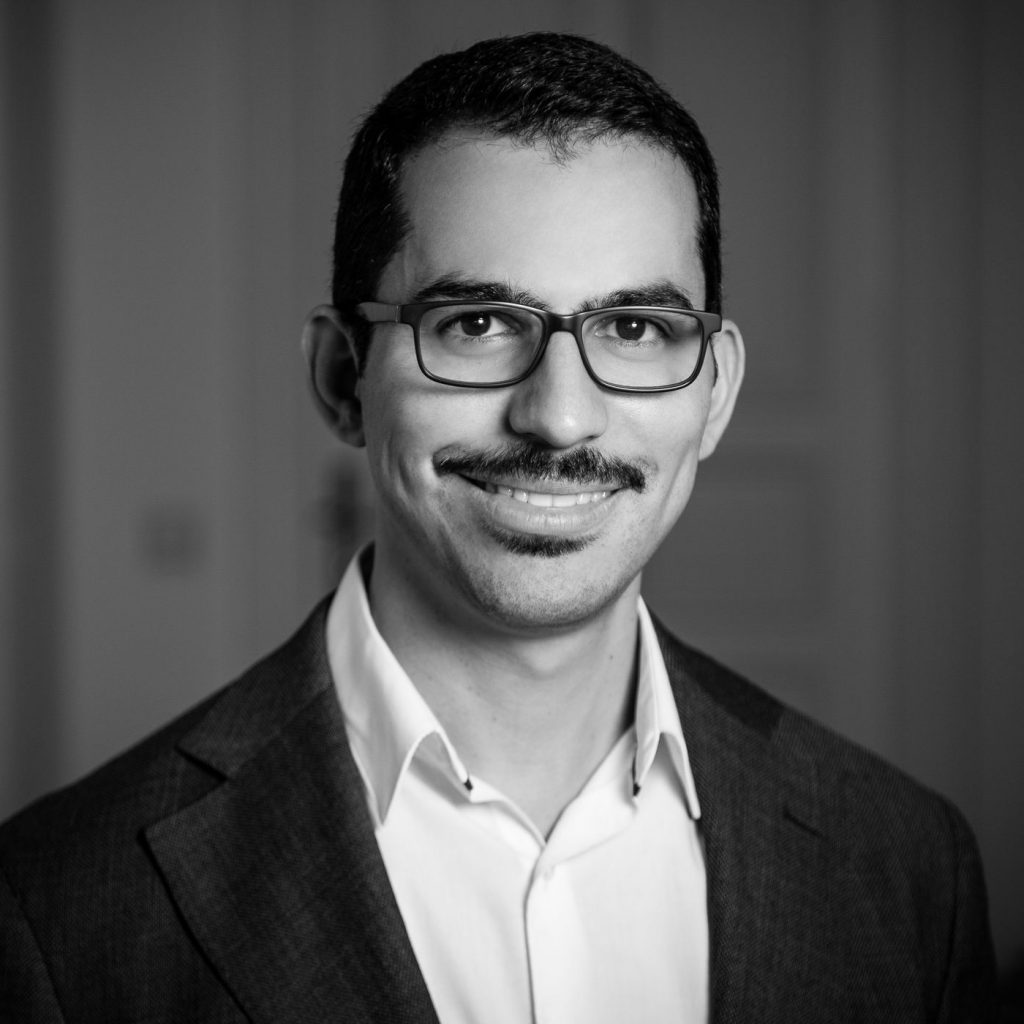
Your contact at Rohrbeck Heger:
Dr. Alejandro Barbesi
Manager
aberbesi@rohrbeckheger.com
LinkedIn
